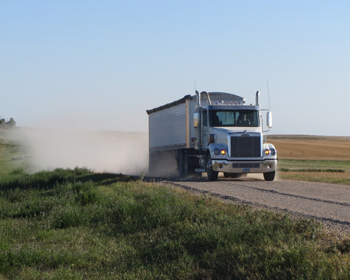Make Room for Safety Around Farm Trucks
Posted: May 20, 2024
 With the cropping season underway, farm trucks are on the move across the region. Safety experts at North Dakota State University remind other drivers to give trucks extra room to operate.
With the cropping season underway, farm trucks are on the move across the region. Safety experts at North Dakota State University remind other drivers to give trucks extra room to operate.
"Farm trucks are large and heavy," notes Angie Johnson, Farm and Ranch Safety Coordinator with NDSU Extension. "They require more room for turning and for stopping than we often expect."
Surveys of farm operators by the Upper Great Plains Transportation Institute (UGPTI) at NDSU indicate that tractor-trailer semitrucks are the most commonly used farm trucks across the region. "The average 5-axle semi loaded with corn weighs more than 75,000 pounds," Johnson says. "Bringing a vehicle of that size and weight to a stop takes about 40% longer than the typical passenger vehicle – up to the length of one a half football fields."
Also because of their size, semitrucks have large blind spots, called "no zones" by the motor carrier industry, where other vehicles are invisible to the driver, Johnson says. If you can't see the driver in the truck's side mirror, it's likely that the driver can't see you. When passing or being passed, do not linger in those blind spots. Cutting in front of a semitruck or following too closely can also put you in a blind spot and dramatically increase your chances of being involved in a crash. More information on no zones is available through the North Dakota Motor Carriers Association website.
The National Safety Council reports that more than 70% of injuries and deaths resulting from large-truck crashes occurred to occupants of other vehicles. "Because of the difference in size and mass between large trucks and passenger vehicles, drivers and passengers are almost always the losers in crashes," Johnson says.
The UGPTI reports that 72% of truck-involved injury crashes in North Dakota occur on rural interstates or other rural roads. On gravel roads, the number of truck-involved injury crashes is significantly higher than injury crashes not involving trucks.
Drivers of farm trucks often face unique challenges posed by rural roads. "Gravel roads or even some paved roads were not designed for the size of trucks that are using them now," says Kelly Bengtson a road and bridge engineer with UGPTI and a former county engineer. "Drivers have to be careful of soft or non-existent shoulders; rutted or damaged road surfaces; and narrow driving lanes," Bengtson says.
A common issue is intersections that weren't designed to give large vehicles enough room to turn. "Drivers may have to swing wide and use multiple lanes to negotiate turns in those intersections." Bengtson says. "Give those drivers room to maneuver."
Bengtson points out that farm trucks may enter roadways from field approaches or stop in unexpected places to deliver crop inputs or service farm equipment. Clouds of dust from gravel road or farm operations may reduce visibility. "It's important to pay attention to your surroundings and be extra cautious any time there are trucks or farm equipment operating in the area," he says.
Johnson said farm trucks may also be driven by inexperienced or youthful drivers (semitruck drivers must be at least 18 years old), so it's best to give them extra space to operate.
Truck drivers need to make sure they operate at safe speeds on rural roads. According to UGPTI research, the most common contributing factors in injury crashes are weather conditions, failure to yield, and traveling too fast for conditions. "Driving a large vehicle is a serious task that requires your full attention," Bengtson says. "You need to be aware of road and weather conditions as well as surrounding traffic and adjust your speed accordingly."
Both Bengtson and Johnson note that patience goes a long way toward preventing most rural truck related incidents. "Being in a hurry to pass, following too closely, or cutting in front of trucks can have deadly consequences," Johnson emphasizes. "Be a defensive driver by anticipating farm truck and equipment operators to make wide turns, unexpected field approach turns and understand that they can be operating at lower speeds which can cause rear-end collisions if you are driving distracted. Take your time when meeting or following farm trucks and equipment, as a few extra seconds or minutes to be cautious is a small price to pay for safety."
###
Contacts
Angie Johnson, NDSU Extension Farm and Ranch Safety Coordinator, (701)231-1873, angela.b.johnson@ndsu.edu
Kelly Bengtson, NDSU/Upper Great Plains Transportation Institute Bridge and Pavement Engineer, (701)231-5361, kelly.bengtson@ndsu.edu